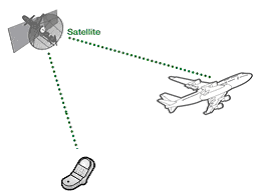Satellite System

Another way to send the cell phone signal from the OMTS to an on ground source is to first route it to a satellite. From the satellite it can be beamed into the mobile operator’s network. The satellite would always be in sync with the airplane allowing the picocell and satellite to have continuous communication.
The OMTS would receive its information in GSM, as specified on the details of the onboard system page. In order to send the signal to the satellite for resending back to the source on the ground it is first converted to IP so it can use the IP link on the satellite. This would probably be IPv6, which makes the router load smaller and thus decreases packet losses that might occur in terrestrial networks. It would then be sent back down to the ground and converted back to GSM or for use on a landline. The actual transmission of the signal from the satellite is handled by a transponder, which can achieve data rates of up to 155 Mbps. Sending signals to and from a satellite requires a large bandwidth. The OMTS operates on the L-band frequency, which is 1.25 GHz. This frequency is ideal for the OMTS because it comes with an ability to make measurements of displacement from the satellite to the ground under a variety of topographic conditions. It provides these measurements at a fine resolution with little interference. This will allow the satellite to send the signal to a precise location on the ground. The OMTS will use a Multi-Phase, Multi-amplitude Phase Shift Keying analog signal, or QAM. This will allow the system to send multiple signals at the same time over one modulated carrier frequency.
Using IP over Satellite has a few advantages. First of all, a satellite can cover a wide range of geographical areas including remote terrestrial regions. This is perfect for this type of system because it can receive the signal from a remote location, the airplane, and send it to just about anywhere in the world that has access to the GSM network or a landline. Satellite also have superior simultaneous broadcasting rate to terrestrial networks, allowing them to handle multiple signals at once. This is ideal for a small group of people in one area, like an airplane, who all might be trying to use their cell phones.
